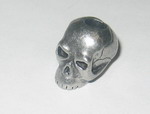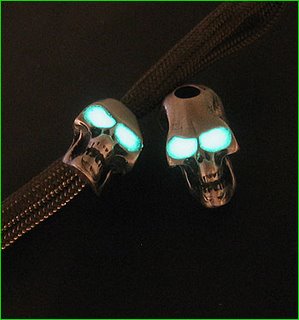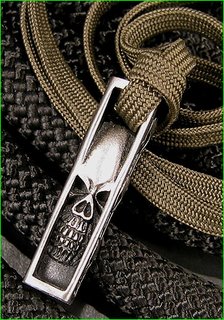A very simple introduction to color
Human eyes are sensitive to one portion of the electromagnetic spectrum, we call this portion of the spectrum "light". Depending on the wavelength of the light source our eyes perceive the light in different colors and tones, the lowest wavelengths our eyes can sense around the 380nm are seen as purple, the highest wavelength around the 740nm as red the rest of the colors are distributed in the middle.
The "location" of the different colors in the spectrum can be described with this ranges:
- Infrared: >740 nm
- Red: 625 ~ 740 nm
- Orange: 590 ~ 625 nm
- Yellow: 565 ~ 590 nm
- Green: 500 ~ 565 nm
- Cyan: 485 ~ 500 nm
- Blue: 440 ~ 485 nm
- Violet: 380 ~ 440 nm
- Near UV: 300 ~ 380 nm
- UV: <300

Objects that are opaque, that do not generate light are seen in colors depending on the way they refract light, some materials absorb red and are then seen bluish, others absorb more the blue wavelengths and are seen in red tones. The important thing is that opaque objects are not colorful, they are just seen in a color because of the way they refract light.
Enter LEDs
LEDs are light sources meaning that they truly "generate" light, the biggest difference with incandescent bulbs is that LEDs can generate light in a very specific wavelength of the spectrum while incandescent light generates all sorts of wavelengths including IR and UV sometimes. An emerald green LED used for traffic lights can generate light around 500nm in the spectrum with almost no radiation at all in other wavelengths, LEDs are therefore "pure" in terms of the color they generate.

The picture shows the spectrum of a red led, as you can see only a very specific wavelength is emitted from the led.
Infra red LEDs
 Infra red LEDs are invisible to the eye since they are beyond the spectrum of visible light. They are normally used in remote controls and other devices for short distance communication of signals.
Infra red LEDs are invisible to the eye since they are beyond the spectrum of visible light. They are normally used in remote controls and other devices for short distance communication of signals.Infra red is commonly used with night vision equipment to "see" things in the dark without using visible light, as you see an object painted with normal light because your eyes are sensitive to light you can see an object painted with IR light because you are using a IR sensitive equipment like a night vision scope. This is also known as "passive" night vision since without an IR source you wouldn't see anything, it is different to "active" systems that are usually thermal and can present colors based on the temperature of an object without any light source present.
IR LEDs can then be used as flashlights for night vision operations, and they can also be used as markers or beacons that will only be visible to those equipped with NV equipment. First generation NV tools can be severely damaged by normal light and can only be used at night.
 Most digital cameras and webcams are sensitive to infra red lights, this means that using a camera you can actually see an infra red light glowing when activated. You can check this quickly pointing a remote control to your digital camera lens and pressing buttons on the remote, if you see the remote control front emitting led lighting up then your camera is sensitive to that wavelength of IR light. Unfortunately the cameras will only be sensitive to a narrow portion of the IR spectrum so one remote control might be visible while another IR led may not.
Most digital cameras and webcams are sensitive to infra red lights, this means that using a camera you can actually see an infra red light glowing when activated. You can check this quickly pointing a remote control to your digital camera lens and pressing buttons on the remote, if you see the remote control front emitting led lighting up then your camera is sensitive to that wavelength of IR light. Unfortunately the cameras will only be sensitive to a narrow portion of the IR spectrum so one remote control might be visible while another IR led may not.Sony cameras with night mode are particularly sensitive and you can use infra red lights to illuminate a photo without any visible light, the picture will be in green/gray tones. You can certainly use an IR LED flashlight to take better pictures in night mode using these cameras.
Infra red radiation is harmful for the eyes so don't point IR sources directly to the eye and avoid long exposure to IR radiation. Many Lasers generate IR radiation along with the color of the Laser so depending on the power of the Laser you may need googles to protect your eyes.
Red LEDs
Red light is found at 670 to 725nm in the spectrum.
 Red is the color that less affects the eyes, this means that at equal intensity a red led will make your eyes work less than a green led or blue led, this is the reason why red is associated with preserving night vision, you can use a good amount of red light before you lose your adaptation to darkness.The rods on your eyes only react to red light at a very high intensity compared to green or blue light.
Red is the color that less affects the eyes, this means that at equal intensity a red led will make your eyes work less than a green led or blue led, this is the reason why red is associated with preserving night vision, you can use a good amount of red light before you lose your adaptation to darkness.The rods on your eyes only react to red light at a very high intensity compared to green or blue light.You should be familiar with the "spots" you see when you accidentally point a bright light to your eyes, like the flash of a camera or a bright flashlight, it is quite difficult to do the same effect using red light since you really need a very good amount of light for the eyes to create the same effect in the retina. The "spots" are not dangerous to your eyes but you shouldn't do it on purpose always try to be on the safe side.
Astronomers have been using red lights for years to read charts and adjust instruments in the dark without losing their adaptation to the dark environment. Night adapted eyes are critical in astronomy since they will be more sensitive to light in the telescope and see more or brighter objects.
Red is the international color for danger or emergencies, a red light can be used to signal an accident or a dangerous place. A red light pointed to a helicopter or airplane will mean "it is dangerous to land here" this and the lack of visibility make red unsuitable for beacons and emergency lights.
Under a red light the red color is more or less invisible, orange is almost lost and yellow barely distinguishable from white. Red makes all the colors look black/gray so they will be very hard to distinguish, magenta is usually a good color if you need to have two tones for something that will be read under a red light.
Red LEDs are quite problematic to read maps specially those that use red for roads or other symbols, they will be completely unreadable under a red light.
Red light is the first to be absorbed by sea water, so it is highly unsuitable for underwater use. For underwater use purple is the best color but since purple LEDs of high intensity are not common green is a good choice, green has good visibility under water and there are a lot of high intensity green LEDs available.
Red LEDs are ideal for night activities as long as you don't have a problem with maps or charts, you can use a fairly good amount of light without making your eyes lose their adaptation to darkness, red is very bad for markers or signaling since is the color that is less visible to the eye.
In stealth operations red is probably the one and only option to have some illumination without the risk of being detected without falling into infrared and night vision equipment.This holds if the "enemy" does not use Night Vision equipment, when that happens some tones of green/turquoise should be used as they are invisible to the IR equipment.
Red's complimentary color is green, so red is recommended whenever you need contrast against a green background. Red is a good light to illuminate green objects.
Yellow LEDs
Yellow is found between 565 and 590nm in the visible spectrum.
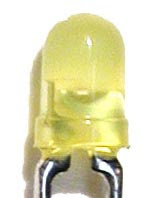 Yellow is usually a softer white, meaning that the eyes will react less to yellow light than to white, yellow is a good color for ambient illumination.
Yellow is usually a softer white, meaning that the eyes will react less to yellow light than to white, yellow is a good color for ambient illumination.Yellow LEDs usually throw further than red and orange ones, meaning you can light up distant objects with less amount of light.
Under a yellow led only yellow tones will be invisible so they are good for reading charts and maps as long as yellow is not used, the colors will look more or less the same; red and orange are the best options as colors that can be distinguished from others using a yellow led. Yellow allows decent night vision and another benefit if the yellow light is reduced bounce-back and glare when reading leading to less eye strain.
Being highly visible and able to throw good distances yellow is a good general purpose color and is usually more efficient in terms of energy consumption than white.
Yellow's complimentary color is purple, yellow is good whenever you need to contrast a purple background.
Orange LEDs
Orange is between 585 and 620nm in the spectrum.
Orange can be seen as a combination of red and yellow, it throws further than red but less than yellow and at the same time it protects night vision a lot better than yellow but worst than red.
Using an orange led, yellows and most tones of orange will be invisible, the other colors will be fine.
Green LEDs (turquoise as a softer green included)
Between 520 and 570nm of the spectrum we can find the color we call "green"
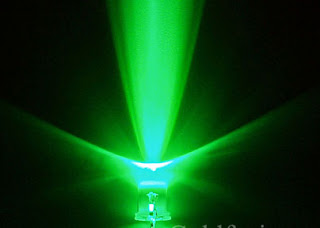 Being in the middle of the spectrum green is the color that the eyes distinguish better, Night vision googles display the images in green because the human eye is very good to detect different shades of green, this makes green a nice general use color since you can detect all the shades and differentiate objects quite well under green light.
Being in the middle of the spectrum green is the color that the eyes distinguish better, Night vision googles display the images in green because the human eye is very good to detect different shades of green, this makes green a nice general use color since you can detect all the shades and differentiate objects quite well under green light.Green is an excellent color for signaling, emergency lights, strobes and markers. Due to the problems mentioned with red lights you will see many articles referring to green as the "new red" for preserving night vision. The fact is that any color can be used for night vision it just changes the intensity that can be used, if you want to use green and preserve night vision you need to use less intensity than with red. So what really matters for night vision is the combination of color and intensity at equal intensity red is the better color, green is in the middle and blue is the worst one.
Under a green light most colors are usually visible as different shades of green, even greens this means that green is a good color to read charts or maps at night. Remember that human eyes can detect many many shades of green so you will be able to ready charts and maps with good accuracy under green light.
The green light will make all the colors appear in the same tone the best colors to contrast with others under a green led are yellow and teal.
Some turquoise LEDs will result invisible to IR night vision equipment so they are good for stealth operations where you don't want to be spotted by night vision equipment.
The complimentary color of green is red, green lights are perfect for red background since red is the color that most contrast offers under green light.
Being in the middle of the spectrum green is a very good general purpose color and the best option for attracting attention and signaling since it is the color that the eyes see better.
Blue LEDs
Blue is between 440 and 490nm in the visible spectrum
 Blue is near the end of the spectrum it is one of the color that most affects the eyes blue is the first color that can be slightly dangerous for vision, it is under discussion but some scientists say that long exposure to blue lights will damage the eyes in the long term. Some people report that exposure to blue LEDs causes headaches, this is not scientifically demonstrated but is certainly a fact to consider when choosing your LED color.
Blue is near the end of the spectrum it is one of the color that most affects the eyes blue is the first color that can be slightly dangerous for vision, it is under discussion but some scientists say that long exposure to blue lights will damage the eyes in the long term. Some people report that exposure to blue LEDs causes headaches, this is not scientifically demonstrated but is certainly a fact to consider when choosing your LED color.Blue LEDs are frequently used to track blood traces or detect blood since blood is very reflective to blue light, some materials might be slightly fluorescent under blue light. Blue light is usually less invasive to animals like deers that have less blue receptors in their eyes than humans that is why blue lights are used by hunters to illuminate their prays without disturbing them as with a bright white flashlight.
Under blue light colors will appear to be the same tone, fluorescent yellow as the color used in text highlighters can be used as a very very noticeable different color.
Blue is a very good color to see contrasts, a blue light is a good idea when you have lost some small object and need to look for it since it will increase the contrast between the object and the floor.
Blue is the color that most affects adaptation to dark vision only very very dim LEDs can be used in the darkness without risking losing the adaptation to the night.
Blue is complimented by orange, blue lights are good to illuminate orange backgrounds.
Blue is a cool color but unless needed for a very specific application it is probably not the best choice for normal use, it is not as visible as green for emergencies and signaling, it is not good for night vision, not suitable for ambient lighting and can even be bad for the eyes.
Cyan LEDs
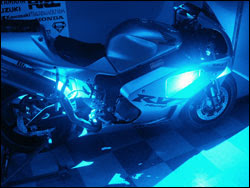 Cyan also called "aqua" is a 50-50 mix of blue and green. It is the complement of red, cyan pigments completely absorb red. Cyan is therefore an excellent choice to detect blood or any other red substance if you need that.
Cyan also called "aqua" is a 50-50 mix of blue and green. It is the complement of red, cyan pigments completely absorb red. Cyan is therefore an excellent choice to detect blood or any other red substance if you need that.Cyan lights share properties of both blue and green LEDs, they can be seen as stronger greens or softer blues. Cyan is good for search lights since blue increases contrasts and the green makes the different shades produced very visible to the eyes.
Purple/Violet LEDs
We find purple LEDs between 380 and 420nm in the spectrum
 Purple and violet are at the end of the spectrum before UV radiation begins, this means that purple LEDs usually do create some amount of UV radiation and for that reason should not be directly pointed to the eyes since UV radiation is potentially very bad for the vision. Remember that UV radiation is invisible to the eyes so it is what you can't see and not what you see what is dangerous.
Purple and violet are at the end of the spectrum before UV radiation begins, this means that purple LEDs usually do create some amount of UV radiation and for that reason should not be directly pointed to the eyes since UV radiation is potentially very bad for the vision. Remember that UV radiation is invisible to the eyes so it is what you can't see and not what you see what is dangerous.Purple LEDs can make many things "glow" or fluoresce depending on the wavelength of the led, many things that fluoresce under UV will have some glow using a purple led. They might be used to quickly test currency, detect blood and some other special uses.
Purple is the complimentary color of yellow so it is a very good option to contrasts against yellow backgrounds.
UV LEDs
 UV is beyond the range of the visible spectrum for humans, some animals like bees can see in UV but humans can not. An UV light will not create any visible light or probably a faint amount of purple, this is dangerous since the faint purple might make the led appear harmless for the vision while the invisible UV radiation produces a lot of damage.
UV is beyond the range of the visible spectrum for humans, some animals like bees can see in UV but humans can not. An UV light will not create any visible light or probably a faint amount of purple, this is dangerous since the faint purple might make the led appear harmless for the vision while the invisible UV radiation produces a lot of damage.UV illumination can be used to make some materials fluorescent, many organic substances like blood will glow, currency has anti counterfeit elements that glow under UV light, scorpions will glow strongly under UV (remember all scorpions are dangerous) and some minerals will glow as well. Tonic water will glow because of the quinine present in the water. Many organic substances will glow.
 White will appear very bright under UV. CSIs and geologists are among the professionals that usually need UV light to work. UV will also charge glow in the dark objects very strongly a quick exposure to UV can make watch hands and other luminescent materials glow for a long time. When using UV light a red/orange filter can be used to highlight the contrasts, you see this frequently in CSI style TV shows.
White will appear very bright under UV. CSIs and geologists are among the professionals that usually need UV light to work. UV will also charge glow in the dark objects very strongly a quick exposure to UV can make watch hands and other luminescent materials glow for a long time. When using UV light a red/orange filter can be used to highlight the contrasts, you see this frequently in CSI style TV shows.For normal use to detect some things or make things glow UV is not dangerous but if you have to be exposed to UV light for long periods of time you will need a protection with UV blocking filters, plastics like polycarbonate generally blocks UV quite well.
White LEDs
 White LEDs are the first LEDs that we examine that do not produce a single wavelength basically white is the addition of all colors so it is not a real color itself.
White LEDs are the first LEDs that we examine that do not produce a single wavelength basically white is the addition of all colors so it is not a real color itself.White LEDs in production today are actually blue LEDs emitting light in the 450nm - 470nm spectrum. These LEDs are covered by a yellow phosphor coating usually made of cerium-doped yttrium aluminum garnet crystals the led emits blue light and part of it so converted to a broad spectrum centered at about 580nm (yellow) by the phosphor. Since yellow light stimulates the red and green receptors of the eye the resulting mix of blue and yellow light gives the appearance of white.
 This approach was developed by Nichia, the blue tint that characterizes many Nichia white 5mm LEDs is because of this. The chart shows the spectrum of a white led with the blue emission being clearly noticeable and the broad yellow centered emission of the phosphor next to it.
This approach was developed by Nichia, the blue tint that characterizes many Nichia white 5mm LEDs is because of this. The chart shows the spectrum of a white led with the blue emission being clearly noticeable and the broad yellow centered emission of the phosphor next to it.White is of course a general purpose color that is used in most flashlights and illumination devices, white is the only color that makes objects reflect light as in daylight so they will maintain their colors, whenever distinguishing colors is a must white should be used.
What about the missing colors?
There are some missing colors in the light spectrum, most notable absent colors are Brown, Magenta and Pink. Brown is a low intensity yellow-green, meaning you have to combine green light and yellow lights at low intensities to produce brown, this is probable the reason why there are no brown leds in the market, a very low intensity green led with a coating to produce some yellow will probably work but the amount of light produced would have to be very very low.
Pink is a combination of white and red, there are some Pink LEDs in the market some of them with marked bluish or red tones. There is a common problem with Pink LEDs degrading after hours of use changing from the vivid pink color to a more red or blue color. This probably means that Pink LEDs are good for novelty toys but not as illumination devices. Girls will just have to wait a little for their pink flashlights with pink LEDs.
Magenta can be obtained combining red and blue light, there are no magenta LEDs in the market since purple LEDs can produce a very similar effect in color yet they are a different thing.
A combination of yellow and orange LEDs is named by some manufacturers "gold", this combination is recommended for fog or environments with moist in the air, snowy places, places with smoke or dust in the air or any other poor visibility atmospheric conditions. The yellow-orange combination minimizes Rayleigh scattering and maximizes its penetration in a way very similar to the automobile fog lights.
An Incomplete list of Flashlights available with color LEDs
- Inova X5: Red, Green, Blue, UV
- Inova X1: Red, Green, Blue, UV
- Inova Microlights Red, Green, Blue, UV, IR
- LEDWAVE Wildfinder 3W Cyan
- LEDWAVE WildFinder II 3W Red
- LEDWAVE Perosnal Defense Light 3W Cyan
- Surefire Kroma White / red & blue
- Surefire Kroma MilSpec White w/ r/g/b/uv/ir
- Photon Microlight Red & Blue
- Photon Microlight II Red, Green, Blue, Yellow, Orange, Purple, NV Green, IR, UV
- Photon Freedom Microlight Red, Green, Blue, Yellow, Orange, Purple, NV Green, IR, UV
- Gerber Infinity Ultra:red
- Peak LED Solutions Matterhorn AAA and Kilimanjaro AA lines: snow white, red, amber, cyan, blue, pink/purple, UV, and RGB.
- Quality China Goods : has a 3 color light (white, green, red)
- Glo-Toob: Has Amber, Red, White, Green, Yellow, IR tubes.
- Tektite has dive lights with different colors
- Rigel Lights: in different colors
- Surefire L1 LumaMax: Red, Green, Blue or White
- Streamlight Stylus in Red, Green & Blue. Key-Mate in Blue or Green. Nightcom in red/white
- Coast (or LED Lenser) has a 4 color LED (white, green, red, blue)
- SureFire KL3/KL1 in red, green or blue.
- Eternalight: Has models with red and other colors
- PentagonLight S2: white, red, blue, green, IR, UV, "gold" (mix of yellow and orange)
- There is is a good page about LED colors on FlashlightReviews.com
- The Wikipedia entry for LEDs
- The Wikipedia entry for color
- A description of LED colors from CMG
- Description of LED colors from LRI (Photonlight.com)
- Several threads and help from Members on CPF
- A very interesting thread on CPF about night vision
- Lot of information, spectral charts and LED analysis on the LED museum
- Excellent post discussing Surefire's A2 LED colors from CPF (Many pics)
















